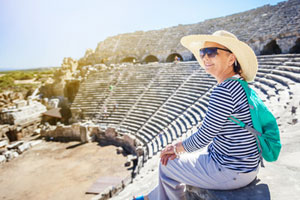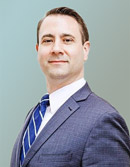Below you will find a real life case study of an individual who is looking for financial advice on how best to arrange her financial affairs. Her name and details of her personal life have been changed to protect her identity. The Globe and Mail often seeks the advice of our VP, Wealth Advisor, Matthew Ardrey, to review and analyze the situation and then provide his solutions to the participants.
![]()
Written by: DIANNE MALEY
Special to The Globe and Mail
Published February 9, 2018

Nancy is 74, a widow with two daughters. Last year, she sold her modest house in a small Ontario city to free up enough money to travel while her health is good. She has no work pension.
Now, Nancy would like to squeeze more out of her investments to give her a bigger travel budget for the next five years. Her goal is to be able to spend a total of $36,000 a year. Longer term, she wants to preserve enough money to cover home care or other health-care needs that might arise.
“Realizing monthly rent and health care may likely increase substantially beyond five years, my goal is to have sufficient projected income to age 95, and have some remaining asset balance as a contingency,” Nancy writes in an e-mail.
“Can my existing RRIF [registered retirement income fund] and financial holdings as structured contribute the monthly income to meet my goals?” she asks.
As with many people, Nancy made the big decisions first and then wrote to Financial Facelift for advice.
Awhile ago, Nancy took her concerns to her daughter, revealing how she had invested proceeds from the sale of her house at her local bank branch. The daughter says shes suspects “the planning and product selection might not have been in her mother’s best interest.”
We asked Matthew Ardrey, a vice-president and financial planner at TriDelta Financial in Toronto, to look at Nancy’s situation.
What the expert says
Nancy is receiving combined Canada Pension Plan and Quebec Pension Plan benefits of $8,577 a year and Old Age Security benefits of $6,996, Mr. Ardrey notes. In addition, she has a small survivor pension of $3,961, which is not indexed to inflation. The balance comes from her RRIF.
Nancy is spending about $2,200 a month today. She would like to travel more and enjoy life now that she has some additional savings, the planner says. Her goal is to spend $3,000 a month during the remainder of her retirement, adjusted for inflation. Nancy feels that this same $3,000 a month would be sufficient to cover off any nursing-home costs she may face in future.
In drawing up his plan, Mr. Ardrey assumes Nancy will live to be 95 and that the inflation rate will average 2 per cent a year. The plan assumes Nancy continues to transfer $5,500 a year from her taxable investment account to her tax-free savings account.
“Reviewing her current portfolio, she has almost three-quarters in bank mutual funds, one-sixth in a GIC [guaranteed investment certificate] and one-tenth in index-linked GICs,” the planner notes. “So just over a quarter of her portfolio is locked in and thus could create a liquidity issue if the stock market were to drop and Nancy needed to draw on her portfolio to cover living expenses,” he says.
“If 40 per cent of her cash and fixed-income allocation cannot be redeemed on demand, it may cause her to have to [sell and thereby] crystallize her equity losses.” To note, the five-year GIC does have a once-a-year redemption on the anniversary date of up to 25 per cent of the initial value.
Nancy’s asset mix is 19 per cent cash equivalents (which includes the GIC, but not the index-linked GICs), 25 per cent Canadian bonds, 5 per cent global bonds, 27 per cent Canadian equities, 15 per cent U.S. equities and 9 per cent international equities. “So she has about a 50/50 mix between equities and the fixed income and cash-equivalent allocation,” Mr. Ardrey says.
This mix seems reasonable for a 74-year-old widow looking for income, he says. “But when we look at the long-term historical rate of return on this portfolio’s underlying asset classes, it is 4.06 per cent.” That’s before deducting the average investment cost of 1.75 per cent a year on the almost three-quarters of her portfolio that is in bank mutual funds.
If past returns continue in the future, Nancy will fall short of her goal, Mr. Ardrey says. She will exhaust all of her savings just after she turns 91.
“To make this scenario feasible, Nancy would have to reduce her spending target by $200 a month (to $2,800), which is about 7 per cent of her overall budget,” the planner says.
Alternatively, she could take steps to improve her asset mix and investment strategy, he says. By replacing the cash assets with low-risk, conservative income investments that act as alternatives to bonds and GICs, for example, and balancing the geographic exposure of her equities, he estimates Nancy would be able to achieve a return of 6.5 per cent a year. Her new asset mix would be 20 per cent alternative income investments, 30 per cent fixed income and 50 per cent equities with an equal distribution among Canadian, U.S. and international markets. “This return, after estimated investment costs of 1.5 per cent a year, would net her 5 per cent a year before inflation.” With this higher rate of return, she would be able to meet her retirement spending goal.
Nancy is not an experienced investor, so she needs help. To get the type of portfolio Mr. Ardrey recommends, she could turn to an investment counsellor, or the investment counsel arm of a financial planning firm. Nancy and her daughter could begin by looking at the website of the Portfolio Management Association on Canada. Investment counsellors charge an annual fee and have a fiduciary duty to act in the best interests of their clients.
Alternatively, because her portfolio may not meet the minimums of some investment counsellors, Nancy could switch gradually to low-fee, balanced mutual funds with solid track records. (Two of the more popular low-fee funds can be bought directly from the fund company with an initial investment of $50,000.)
Even with the higher return, Nancy will have very little cushion, Mr. Ardrey says. “This leaves very little room for error in her budgeting.” He suggests she review her budget now to ensure she will have the money she needs in future.
++++++++++++++++++++++++++++++++++++++
The person: Nancy, age 74
The problem: How to generate a little more return from her investments.
The plan: Shift gradually from bank funds and GICs to a lower-cost fund company or investment counsel.
The payoff: A return high enough to allow her to travel more, at least for awhile.
Monthly net income: $2,945
Assets: Term deposits $10,630; income portfolio $99,055; GICs $50,000; RRIF $98,805; TFSA $52,230. Total: $310,720
Monthly outlays: Rent $1,000; utilities $100; insurance $10; transportation $160; groceries $250; clothing $10; gifts, charity $50; travel $250; dining, drinks, entertainment $85; personal care $40; club membership $30; medical, drugstore $75; phones, TV, internet $140. Total: $2,200
Liabilities: None
Want a free financial facelift? E-mail finfacelift@gmail.com. Some details may be changed to protect the privacy of the persons profiled.

